It was February 2004 when WAP did launch the idea of an Antarctic Activity Week. From that time, every year several Hams and Clubs, join the annual 8-day event, which purpose is to recognize and bring attention to the scientific communities and the work they do in the Antarctic.
 Here below, just some of the comments coming from participants:
Here below, just some of the comments coming from participants:
From KØANT- Antenna Club in Johnson County, Overland Park, Kansas-USA
This is the 18th year of the annual happening, and the 11th year that The Kansas Antenna Club in Johnson County has supported this event.
Club founder and call sign Trustee, Jim KBØMZF did send a message to the Club members: «Unfortunately, due to COVID-19 protocols, the Kansas City authority has indicated that are not currently allowing groups such as ours, to conduct events in our headquarters. So, our AAW outing to there, will not be available as an activity. We are disappointed, because it has always been a fun way to share HAM radio with the public, but we do of course understand their need for that policy this year. However, if you are a Member in good standing, you still have permission to use our KØANT Club call sign to make contacts from your home station at any time during the 8-day event. You are invited to participate and help our Club support»
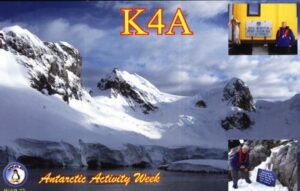 From K4A, PHILIP W FINKLE, K6EID from Marietta, Georgia-USA
From K4A, PHILIP W FINKLE, K6EID from Marietta, Georgia-USA
Just completed this years AAW, made 696 QSOS all on digital FT4 and FT8.
Here’s my annual stats since 2007: This year we had bad solar activity for 3 days that pretty much killed most propagation.
Year QSOs
2021 696
2020 737
2019 952
2018 457
2017 776
2016 340
2015 338
2014 545
2013 473
2012 783
2011 916
2010 635
2009 699
2008 712
2007 1101
I have already reserved K4A for 2022, said Phil!
 From Volker DL8JDX, Altötting, Germany
From Volker DL8JDX, Altötting, Germany
Thanks again for organizing the AAW 2021. It was fun again working many AAW Special Event Stations. During this AAW and during this Antarctic Summer Season, I could work following stations:
12 WAP SES Stations:
EH3ANT WAP-292
EM25VER WAP-312
IB2ANT WAP-308
II2ANT WAP-030
II5ANT WAP-025
II8WAP WAP-297
IR1ANT WAP-002
K4A WAP-073
LZ18ANT WAP-311
OE18AAW WAP-309
PF88ANT WAP-307
TM18AAW WAP-310
7 Antarctic/Sub-Antarctic Stations:
RI01ANT RUS-11
LU1ZG ARG-06
VP8LP GBR-25
VP8NO GBR-25
VP8/SQ1SGB GBR-40
ZS7ANF MNB-12
DP1POL DEU-08
2 Antarctic Research Ships:
RX6A/mm Akademik Tryoshnikov
DP0POL/mm Polarstern
Looking forward to the next upcoming season, said Volker!
Congrats to everyone who did join the 18th AAW, and don’t forget to aplly the “free” 18th AAW Award, available online (TNX IK3GER)
See: http://www.waponline.it/antarctic-activity-week/aaw-2021/

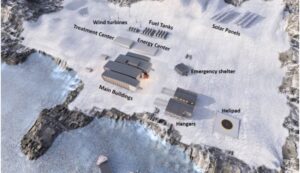 The planned Turkish Antarctic Research Station (TARS) is to be built in the southern part of the Antarctic Peninsula on Horseshoe Island. Between 24 and 50 people are to be accommodated in the station, which is to operate all year round. The graphic shows the various buildings and structures planned. (picture aside)
The planned Turkish Antarctic Research Station (TARS) is to be built in the southern part of the Antarctic Peninsula on Horseshoe Island. Between 24 and 50 people are to be accommodated in the station, which is to operate all year round. The graphic shows the various buildings and structures planned. (picture aside) United Kingdom to the Antarctic Treaty Consulttive Meeting.
United Kingdom to the Antarctic Treaty Consulttive Meeting.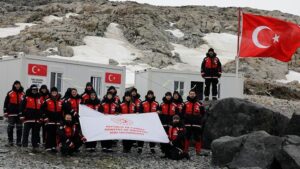 Turkey is one of the youngest Antarctic nations and is hitting the accelerator. A first Antarctic expedition with Turkish participation was launched in 2016 together with Ukraine.
Turkey is one of the youngest Antarctic nations and is hitting the accelerator. A first Antarctic expedition with Turkish participation was launched in 2016 together with Ukraine. Located at 66°14’59” South, 100°36’12” East, Edgeworth David is a summer-only Station, a research outpost named after Sir Edgeworth David.
Located at 66°14’59” South, 100°36’12” East, Edgeworth David is a summer-only Station, a research outpost named after Sir Edgeworth David. geophisical, geomorphologogical and biological research.
geophisical, geomorphologogical and biological research. Pakistani researchers are keen to revive scientific exploration in the Antarctic region. Officials have expressed a desire to revitalize expeditions in Antarctica by Pakistani scientists in collaboration with friendly countries.
Pakistani researchers are keen to revive scientific exploration in the Antarctic region. Officials have expressed a desire to revitalize expeditions in Antarctica by Pakistani scientists in collaboration with friendly countries. Jinnah Antarctic Station
Jinnah Antarctic Station 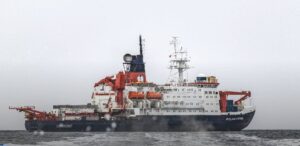 The German Research Vessel Polarstern has made a remarkable circumnavigation of Antarctica’s latest mega-iceberg. It was an opportunity too good to miss for the research icebreaker, which is operated by the Alfred Wegener Institute (AWI) in Bremerhaven.
The German Research Vessel Polarstern has made a remarkable circumnavigation of Antarctica’s latest mega-iceberg. It was an opportunity too good to miss for the research icebreaker, which is operated by the Alfred Wegener Institute (AWI) in Bremerhaven.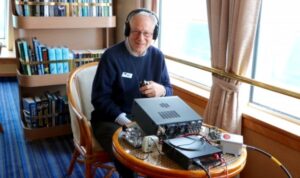 activity as VP8DPC/m and C6AMD/mm.
activity as VP8DPC/m and C6AMD/mm.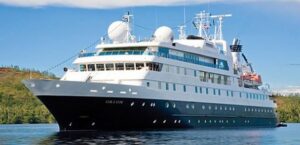
 Starting October 15, 1956, the Soviet Union built a Scientific Station by the name of Oazis (Оазис) at the shore of the Algae (Figurnoje) Lake in the center of Bunger Lakes or Bunger Oasis’s area. The Oazis Base located at 66° 16′ 29″ South, 100° 44′ 49″ East, consisting of two wooden houses ca. 20 m2 each and a few smaller buildings, was able to accommodate eight people. The station was handed over by the Soviet Accademy of Sciences to Poland on January 23, 1959, and was renamed Antoni B. Dobrowolski Station. It continued to be occupied for a few weeks only thereafter.
Starting October 15, 1956, the Soviet Union built a Scientific Station by the name of Oazis (Оазис) at the shore of the Algae (Figurnoje) Lake in the center of Bunger Lakes or Bunger Oasis’s area. The Oazis Base located at 66° 16′ 29″ South, 100° 44′ 49″ East, consisting of two wooden houses ca. 20 m2 each and a few smaller buildings, was able to accommodate eight people. The station was handed over by the Soviet Accademy of Sciences to Poland on January 23, 1959, and was renamed Antoni B. Dobrowolski Station. It continued to be occupied for a few weeks only thereafter. The still in place magnetic observatory building (“Oasis Station Observatory”), along with a plaque commemorating the establishment of Oasis Station in 1956, has been designated a Historic Site or Monument (HSM 10) following a proposal by Russia to the Antarctic Treaty Consultative Meeting (ATCM).
The still in place magnetic observatory building (“Oasis Station Observatory”), along with a plaque commemorating the establishment of Oasis Station in 1956, has been designated a Historic Site or Monument (HSM 10) following a proposal by Russia to the Antarctic Treaty Consultative Meeting (ATCM). Here is a testimony told by Jorge Canova, pilot of the Argentine Air Force who is sharing the image of Nuestra Señora de Loreto enthroned at Matienzo Base during the 1970/71 Antarctic campaign.
Here is a testimony told by Jorge Canova, pilot of the Argentine Air Force who is sharing the image of Nuestra Señora de Loreto enthroned at Matienzo Base during the 1970/71 Antarctic campaign. Here below, just some of the comments coming from participants:
Here below, just some of the comments coming from participants:

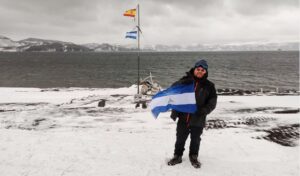 This 34-year-old is the first Nicaraguan at the “Gabriel de Castilla Base” (WAP ESP-Ø2), one of the two Spanish bases located on Decepción Island in the South Shetland Islands Archipelago, in Antarctica. There he saw how the Spanish military placed the flag of Nicaragua on the flagpole, along with that of Spain, a gesture that shocked him and filled him with pride.
This 34-year-old is the first Nicaraguan at the “Gabriel de Castilla Base” (WAP ESP-Ø2), one of the two Spanish bases located on Decepción Island in the South Shetland Islands Archipelago, in Antarctica. There he saw how the Spanish military placed the flag of Nicaragua on the flagpole, along with that of Spain, a gesture that shocked him and filled him with pride.